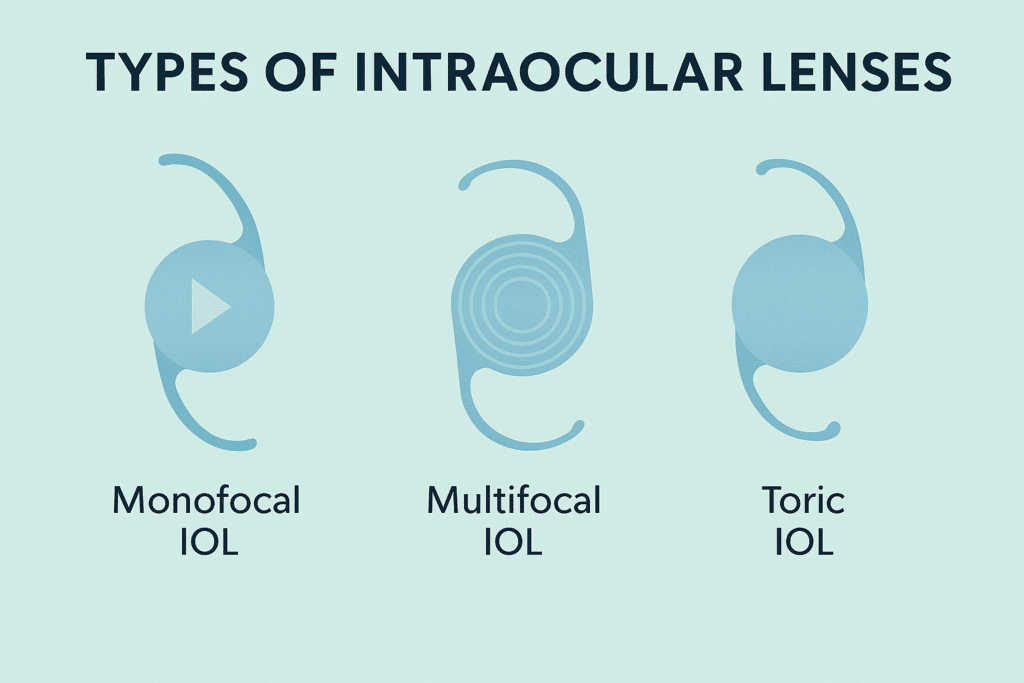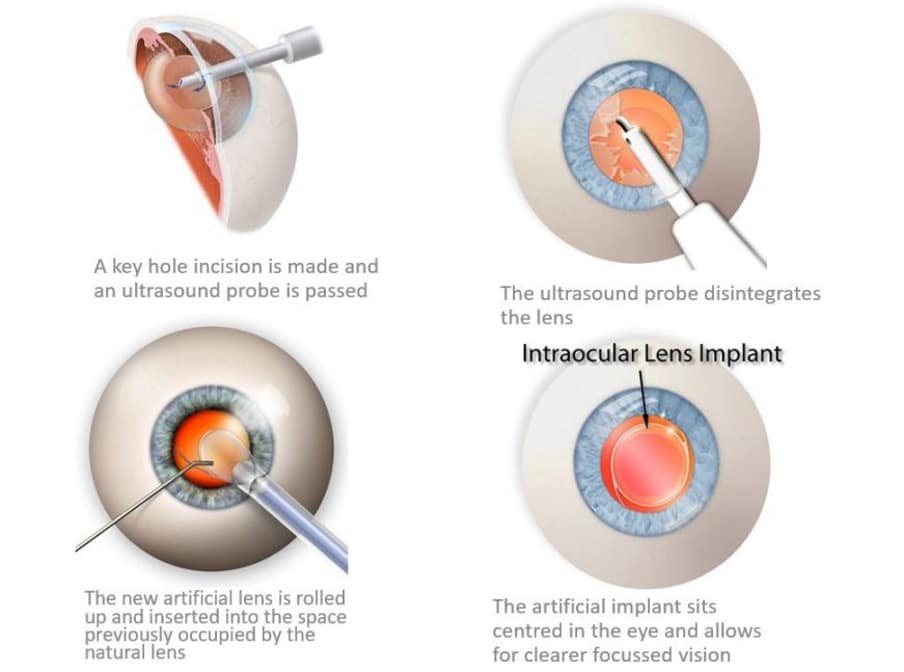You might be surprised to learn that multifocal or trifocal lenses can reduce your need for glasses in more than 90% of your daily activities. These cutting-edge lens implants use special technology that improves your vision at multiple distances. The results give you remarkable visual freedom after lens replacement surgery. The procedure has become one of the most successful operations in the UK, with doctors performing more than 3 million cataract surgeries each year. Nearly 96% of patients achieve excellent vision outcomes.
Your journey to adapt to multifocal vision needs some patience. The early healing stages might bring temporary side effects. Patients often experience mild discomfort, sensitivity to light, or slightly blurry vision. Some people notice haloes and glare at first, but these effects usually fade within 3-6 months as your brain adapts through neuro adaptation. Most patients see a reduction in these visual disturbances within weeks after their surgery.
This piece offers practical tips to smooth your adaptation period, whether you’ve had multifocal lens surgery recently or you’re thinking about this transformative procedure. We’ll help you welcome the benefits of your improved vision.

Understanding Your New Vision: How Multifocal Lenses Work
Your new multifocal lenses will help you see better after lens replacement surgery. Learning how these lenses work can speed up your adaptation to improved vision. Standard lenses focus at one distance, but multifocal technology gives you clear vision at multiple ranges. This technology offers greater visual freedom in your daily activities.
What is the difference between multifocal and progressive lenses?
People often mix up multifocal and progressive lenses. These lenses serve similar purposes but work differently. Surgeons implant multifocal lenses inside your eye during surgery. Progressive lenses work as external eyeglasses. Both types correct vision at various distances. Progressive lenses, also known as progressive addition lenses or PALs, smoothly transition between different prescription powers without visible lines. You can see objects clearly at near, intermediate, and far distances without switching glasses.
Multifocal lens implants replace your natural lens through surgery. These advanced implants create multiple focal points by dividing light. This allows you to see objects at different distances at the same time. The biggest advantage comes from not needing external eyewear. Research shows that all but one of these patients needed glasses with standard monofocal lenses (95%), while only 68% needed them with multifocal implants.
How multifocal lens implants provide near, intermediate, and distance vision
Advanced optical engineering in multifocal lens implants creates multiple focal points within a single lens. Light splits into different focus areas that match specific viewing distances. These lenses use refractive or diffractive technology, and sometimes both:
- Refractive multifocal lenses split light into various focal points using concentric rings with different powers. They typically give exceptional distance and intermediate vision.
- Diffractive multifocal lenses create multiple focal points through microscopic steps on the lens surface. They excel at distance and near vision.
Your brain adapts to these focal points over time. This neuro adaptation means your vision gets better as your brain learns to process information from your new multifocal lens.
What is the difference between trifocal and multifocal lenses?
The names of these lenses might sound confusing. “Multifocal” means any lens with more than one focal point. This category includes bifocal designs (two focal points) and trifocal designs (three focal points). Trifocal lenses showcase the latest lens implant technology. Standard multifocal lenses focus mainly on near and distance vision. Trifocal lenses add a third focal point for intermediate vision – about arm’s length. You get clearer vision for computer work, cooking, or shopping without losing distance or reading ability.
The main difference shows up at intermediate distances. Traditional multifocal implants might not work well for intermediate vision. Trifocal designs want to give you continuous clear vision at all distances. Some patients using standard multifocal lenses might need awkward postures or glasses for computer work. Trifocal designs might reduce glare and halos at night compared to some multifocal options. Your brain needs time to process multiple images with any advanced lens design.
Clinical studies reveal high patient satisfaction with both lens types. Research shows 97.5% of patients would recommend this procedure. Most patients don’t need glasses for daily activities. Some might prefer reading glasses for long periods of close work or tiny print.

Common Side Effects and How to Manage Them
Multifocal lens implants give you excellent vision at multiple distances. Your eyes need time to adapt, and you might notice some temporary visual changes. Let’s look at what these effects mean and how you can feel confident during the adjustment period.
Glare, halos, and starbursts explained
After multifocal lens surgery, your eyes process light differently. These visual changes happen because multifocal lenses split incoming light to create multiple focal points:
- Glare makes it hard to see in bright light conditions. This becomes noticeable when headlights approach you during night driving.
- Halos show up as rings of light around bright objects, especially when it’s dark.
- Starbursts create streaks or rays that extend from light sources.
These visual changes naturally occur with your new intraocular lenses. Research shows that positive dysphotopsia (the technical term for these light-related phenomena) affects up to 67% of patients right after surgery. Light-related effects are 3.5 times more common with multifocal IOLs than standard monofocal lenses.
How long do these effects last?
The good news is that most visual disturbances fade away. Halos and glare decrease noticeably within the first few weeks after surgery for most patients. Your brain continues to adapt to the new visual input through neuro adaptation.
Recovery times vary among patients:
- Most people see big improvements within 3-6 months
- A small group (less than 2% of patients) might experience longer-lasting effects
- Only 0.13% to 3% of patients still have symptoms after one year.
Tips to reduce discomfort during adaptation
Your brain needs time to adjust. Here are some helpful strategies to manage these visual effects:
- Optimise lighting conditions: Warm, indirect indoor lighting works best. Avoid looking straight at bright lights
- Anti-reflective eyewear: These special glasses reduce glare and light scatter, even if you don’t need vision correction
- Night driving safety: Look slightly left of approaching headlights to minimise halos
- Eye drops: The right drops keep your eyes lubricated and might reduce discomfort
- Patience helps: Your brain needs time to process visual information from your new lenses
When to seek professional advice
Most adaptation issues are temporary, but you should call your eye specialist if:
- Visual disturbances affect your daily life too much
- Symptoms suddenly get worse after your initial recovery
- Vision quality changes unexpectedly
Precision Vision London’s specialists excel at guiding patients through adaptation. Regular check-ups help us track your progress and give you personalised advice for any lasting effects. Note that almost everyone adapts well to their multifocal lens implants. Studies show that all but one in fifty people fully adjust to these advanced lenses.
Adapting to Daily Life with Multifocal Vision
Becoming skilled at daily activities with your new multifocal lenses takes some adjustment. Most patients develop strategies that improve their visual experience quickly. Your brain will adapt to processing multiple focal points at once, and these practical approaches will help you direct daily tasks with more confidence.
Reading, screen use, and night driving
You’ll need to experiment with reading positions after lens replacement surgery. Try holding reading materials at different distances to find your best focus point. Most multifocal lens recipients adapt faster when they practise reading regularly start with larger print before moving to smaller text. Your screen position or chair height should match your eyes with the top third of your monitor for computer work. This arrangement lets you use the intermediate vision zone of your lenses well. Bifocal implants might create a slight “dead zone” at intermediate distances, while trifocal designs typically solve this issue.

Night driving needs extra caution at first. You might notice halos or glare around headlights and streetlamps during the adaptation period. These visual issues usually fade over time, yet about 43.8% of multifocal patients say their vision worsens in bright outdoor lights. Regular night driving should be discussed with your surgeon before surgery since it could affect your lens choice.
Adjusting to depth perception changes
Your new lenses might temporarily disrupt your depth perception, especially when you traverse stairs or uneven surfaces. Studies show multifocal glasses wearers fall more than twice as often as non-multifocal wearers. So take extra care when walking outside or using stairs.
These techniques will help you adapt safely:
- Move your head slightly (not just your eyes) when changing focus
- Take time on stairs and uneven surfaces
- Use handrails when available
Using lighting to your advantage
Good lighting substantially affects your visual comfort with multifocal implants. Research shows trifocal lens users do best with intermediate light temperature (around 4,000K), while bifocal lens recipients need more intense lighting (75 FC). Both lens types work better with intermediate light temperatures for reading tasks. Your home and work environments should have adjustable, non-glaring light sources for the best results. Good lighting matters most for reading, as studies show reading rates can drop by 4-8% with multifocal correction compared to single vision.
How to support your eyes with nutrition
Good nutrition helps your recovery and long-term eye health. A balanced diet rich in antioxidants protects your eyes from oxidative damage. Add these eye-supporting nutrients to your daily meals:
- Omega-3 fatty acids (found in fatty fish) to reduce post-surgical dry eye symptoms
- Vitamin C from citrus fruits and berries to lower inflammation
- Zinc-rich foods to help wound healing and immune function
- Leafy green vegetables containing lutein and zeaxanthin
- Drink 2-3 litres of water daily to keep your eyes properly lubricated.
Recovery Timeline After Lens Replacement Surgery
The healing process after lens replacement surgery follows a clear pattern. Most patients experience similar recovery timelines, which helps surgeons create reliable recovery plans. This timeline will help you prepare for each phase of your post-surgical experience.
Recovery time for lens replacement surgery: week-by-week
- First 24-48 hours: Your vision might be bright but blurry right after surgery due to pupil dilation and early healing reactions. The anaesthetic’s effects wear off and you may feel mild discomfort. Your eye starts healing as the small incision begins to close during this vital period.
- Days 3-7: Vision improves noticeably for most patients in the first week. Any discomfort should fade gradually. Light activities are usually fine, but swimming isn’t allowed yet.
- Weeks 2-4: Most patients return to their daily routine by the second week. Your eye adjusts to the new lens and any glare or halos start to fade.
- Beyond 4 weeks: Complete visual recovery takes 4-6 weeks, and full healing happens within eight weeks. Halos and light streaks might take 10-12 weeks to disappear completely for some patients.

When vision stabilises
Vision starts to stabilise 2-3 weeks after surgery for most patients. Your eye needs 4-6 weeks to fully adjust to the new lens. Your brain’s adjustment to processing visual information through multifocal or trifocal lenses can cause normal fluctuations in vision clarity.
What to expect at each follow-up
Your aftercare experience has these key appointments:
- First day: Your surgeon checks your eye’s pressure and healing progress.
- One week: We assess your vision improvement and address concerns.
- Three weeks: We evaluate your stabilisation and healing.
- Annual examinations: We monitor your eye’s health and lens performance regularly.
How Precision Vision London supports your recovery
Precision Vision London’s aftercare programme has complete support after your lens replacement surgery. Our team provides detailed guidelines about post-operative care, proper eye drop usage and activity limits. We also run a 24-hour helpline for the first 12 months after surgery to support you whenever needed. Multifocal vision takes time to master but transforms lives. Precision Vision London’s personalised aftercare helps your eyes adjust for the best possible clarity. Book your follow-up consultation today and let us guide you toward sharper vision.
Making the Most of Your New Vision
Multifocal lens surgery provides remarkable long-term benefits that go beyond better vision. The results can boost your daily routine in many ways.

Reducing dependence on glasses
Studies show multifocal lenses help people rely less on corrective eyewear. 68% of multifocal lens recipients need glasses after surgery, compared to 95% of patients with monofocal lenses. Patients can perform 90% of their daily activities without spectacles.
How multifocal lens surgery improves quality of life
The surgery’s effects on well-being are clear. About 88% of patients say their quality of life got better after the procedure. Health-related quality of life scores jump from 0.938 to 0.955 within six months. Vision-related quality of life scores also increase from 85.32 to 96.57.
Why refractive lens exchange is a long-term solution
Multifocal lens implants give you a permanent fix, unlike temporary vision corrections. You won’t develop cataracts in the future because your natural lens is removed. Your vision stays stable after surgery and needs only minor tweaks occasionally.
Choosing the right lens for your lifestyle
Your visual needs determine the best lens choice. Trifocal designs work great for computer tasks. Some lenses suit night drivers better. Precision Vision London provides personalised aftercare to help your eyes adjust and achieve the best clarity. Book your follow-up consultation today and let us support your path to sharper vision.
Conclusion
Your new multifocal vision needs patience and understanding to adapt, but the benefits are worth the short adjustment period. Your brain learns to process multiple focal points at the same time. This gives you clear vision at different distances without depending on glasses all the time. Most patients see substantial improvements within weeks after their surgery. Complete neuroadaptation usually takes 3-6 months. Your brain adapts during this time, and the original visual effects like halos or glare around lights start to fade. The practical strategies for reading, screen use, and night driving will help you direct your daily activities with more confidence.
Good lighting and the right position of reading materials boost your successful adaptation. Proper nutrition also plays a vital role. You should know that your vision will keep getting better over time, which helps during the adjustment phase. Precision Vision London’s expert surgeons and dedicated team support you through the whole recovery process. Our complete aftercare programme gives you personalised guidance at every follow-up visit. You also get access to our 24-hour helpline in your first year after surgery.
The lasting benefits of your multifocal lens surgery go way beyond better vision. Without doubt, not having to search for reading glasses makes life easier. You can now fully involve yourself in activities without visual limits. These advanced lenses also prevent future cataracts and boost your quality of life substantially. Getting multifocal lens replacement is an investment in your visual future. Thousands of UK patients have completed this same trip and now enjoy exceptional visual freedom with these advanced lenses. This fact should give you confidence as you adapt to your new vision.
FAQs
Q1. How long does it typically take to adapt to multifocal lens implants? Most patients adapt to multifocal lens implants within 6-12 weeks. During this period, your brain learns to process the new visual information. Some initial effects like glare or halos around lights usually diminish over time.
Q2. What are some effective strategies for adapting to multifocal lenses? To adapt to multifocal lenses, start by wearing them for short periods each day and gradually increase wear time. Optimise lighting conditions, adjust screen positions for comfortable viewing, and practise reading at various distances to find your optimal focus points.
Q3. Are there any drawbacks to multifocal lens implants? Some patients may experience visual phenomena such as rings or halos around lights, particularly when driving at night. However, these effects typically decrease as your brain adapts to the new lenses over time.
Q4. How soon can I resume normal activities after multifocal lens surgery? Most patients can return to light activities within a week of surgery. By the second week, you can typically resume normal daily activities. However, complete visual recovery usually takes 4-6 weeks, with full healing occurring within eight weeks.
Q5. Will I still need glasses after getting multifocal lens implants? The majority of patients achieve independence from glasses for over 90% of daily activities after multifocal lens implantation. However, some individuals may still prefer reading glasses for extended close work or very small print.
Authors & Reviewer
-
 Olivia: Author
Olivia: AuthorHi, I'm Olivia, a passionate writer specialising in eye care, vision health, and the latest advancements in optometry. I strive to craft informative and engaging articles that help readers make informed decisions about their eye health. With a keen eye for detail and a commitment to delivering accurate, research-backed content, I aim to educate and inspire through every piece I write.
-
 Dr. CT Pillai: Reviewer
Dr. CT Pillai: ReviewerDr. CT Pillai is a globally recognised ophthalmologist with over 30 years of experience, specialising in refractive surgery and general ophthalmology. Renowned for performing over 50,000 successful laser procedures.

